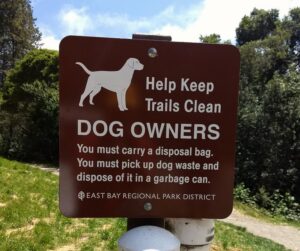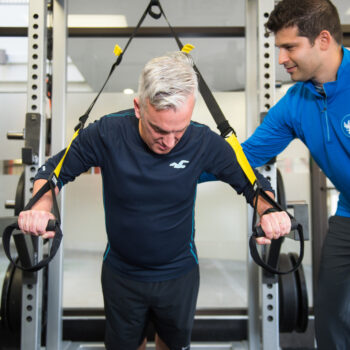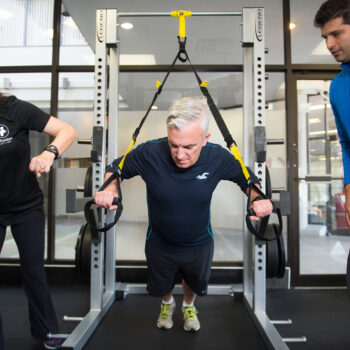Did you know there are 1065 trails, including 713 hiking trails in BC, over 90 in Vancouver alone? With all these accessible options, you have to get out there! We’ve been really lucky that Shadow has the ability to hike with us as there are many, many dog friendly hikes available (over 20 in Vancouver) – one of our favourite resource to access these hikes is found here: https://www.vancouvertrails.com/blog/dog-friendly-hikes-in-vancouver/
When we first started hiking, it was a little trial and error to discover what we needed and more importantly, what Shadow needed. Over time we were able to come up with a solid “dog hiking must haves” checklist that I’d love to share with you.
This list is best used for short day hikes, 6 hours or less.
Hiking with Dogs Tip 1: Visit your vet
Ask your vet if there are any specific vaccinations or preventative treatments that may be needed for the area you are in. Lakes or ponds along your hike might be at risk for carrying water borne pathogens like Leptospirosis or giardia, which can be life threatening to your dog.
If you’re hiking in Vancouver, there’s a low likelihood of snakebites, but dry areas like Osoyoos and the Kootenays do have snakes. A quick Google search can help you find out if you should ask your vet about treatment of snakebites or other wildlife preventative measures. Tick outbreaks have not been a huge issue our BC radar recently, but it doesn’t mean they aren’t out there.
Consider having your pup micro-chipped in case you are separated on the trail.

Hiking with Dogs Tip 2: Consider your dog’s age
If you are welcoming a new young puppy to your family, you may need to wait a few months until they have received all their shots (about 5 months) and their bones are strong enough for a hike. Of course this also depends on how you define hike! Short, forested trails shorter than an hour should be fine, but maybe plan for the Cheifs or BCMC next season.
Dogs that are in their senior years may lack the stamina and strength for long hikes, and if their immune system is compromised, it might put them at greater risk than a young pup.
Shadow is 12 and while he still enjoys a 6 hour hike, he is definitely slower than he was at age 10. We just take our time and ensure he has lots of water breaks and give him a lot of encouragement and praise along the way.

Hiking with Dogs Tip 3: Consider your dog’s breed and personality
Most owners know that brachycephalic breeds, or short-muzzled dogs like pugs, boxers, Boston terriers and bulldogs don’t do well in heat as their morphology can make it dangerous to take them on long, hot summer hikes. This doesn’t mean they aren’t able to enjoy a good hike, just pick something shorter, go on cooler days in the spring or fall, and keep an eye on their status and energy levels.
Most dog owners also know that personality plays a big role in what kind of activities your dog will enjoy. Dogs that get easily over excited and over stimulated might be an issue on a hike if the trail is shared by riders on horses, mountain bikes or is very busy. Or in our case, has “too many” squirrels. Try a practice hike on a quieter trail to allow your dog to become accustomed to sights and smells and remain a bit more calm.
Hiking with Dogs Tip 4: Start off easy
If your pup is new to the hiking scene, pick hikes shorter than an hour, or on relatively level terrain to start off the season season. Depending on how much activity your dog gets during off-season, monitor their energy levels and adjust your pace and take breaks appropriately.
Even if they are “fit enough” and active all year long, their paws need time to toughen up. Some trails are littered with sharp rocks or have paved surfaces that get very hot. A paw salve might help condition their feet for longer treks.
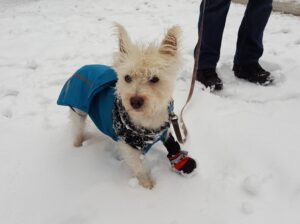
Hiking with Dogs Tip 5: Gear for your pup
Booties offer protection from sharp rocks, thorns and if you hike offseason, snow and ice. Be aware that you’ll need time to get your pup used to wearing booties before the hike, and you might lose a bootie (or if they’re like Shadow…they’ll lose 3), so pack spares.
A harness is great if your dog is a puller, or if they can easily slip through a collar. Harnesses with handles is great for safety when crossing unfamiliar water or carrying them over obstacles
Ensure your dog is wearing a collar with a tag and important details like your contact info, dog licence number and telephone number in case you are separated.
Some larger breeds of dogs can carry a dog pack, which may be used to carry their own items, including food, water and info. Much like wearing booties, take your dog to the pet store and find one that has a good fit and take the time to let your dog get used to wearing a pack (they look like saddlebags).

Dog Backpack – This is an item we were very excited about as Shadow does need help up and down some parts of our hikes, or gets pooped on long hikes, so we ordered the K9 sport sack so we can carry Shadow! Of course this only works with small / medium dogs less around 30 lbs. Shadow is about 23 lbs and we find hiking with him in the Sport sack hard a bit on the shoulders for more than 30 minutes, but thankfully it’s for short sections and Shadow would rather be self-powered, when possible.
A lot of hikers wear a bear bell, but on trails that allow dogs to be off-leash, we attach the bell to Shadow so we can keep an eye and “ear” on him. Again, depending on the hike and the region, this may or may not be necessary, but given it’s a whopping $3 expense and we hike weekly, it’s worth it. (Especially when we hike in the snow and he blends in with the scenery).
Hiking with Dogs Tip 6: Pack food and water
Water – we strongly recommend bringing enough fresh water and a lightweight collapsible dish for your dog. You’ll want to bring about 0.5 to 1.5 ounces of water per pound on the hike. Of course, just like the human “8 glasses a day” recommendation, this is just a guideline that you’ll need to modify based on ambient temperature, intensity and length of hike. Your dog may want to drink stream or lake water (raw water, so trendy) but discourage this as these sources can carry waterborne pathogens that can make your dog very sick. Consult with your vet if you are concerned about this.
Food and snacks – Pack your dog’s favourite food, plus an additional 30-50%, depending on how long the hike is. Give them a small serving about an hour before the hike and then small portions throughout the day. Shadow once scarfed down his entire lunch in one go, then threw up as we were running down Eagle Bluff’s switchbacks.

Hiking with Dogs Tip 7: Be aware of hazards on the trail
Yes, we have bears, cougars and coyotes wandering our woods. While these animals typically shy away from people and popular trails, you never know what kind of conditions might force them into close-encounter situations. BC also has other dangerous wildlife such as snakes, porcupines and ticks to be aware of. Shadow loves to chase squirrels and if he was off leash, that might be the last we’d see of the little guy so in these scenarios. Alternatively, we don’t want our dogs to be a threat to native wildlife, so leashes are great multitaskers.
Wild plants can pose a threat in the form of poisons or rashes. We might know what poison oak, poison ivy, sumac or toxic mushrooms might look like, your dog very likely doesn’t. One danger that can be found in some areas of BC are foxtails, a particular type of grass seed, which can be deadly. If you notice excessive sneezing, head shaking, eye discharge or an abscess, seek medical attention immediately. (https://www.cbc.ca/news/canada/british-columbia/foxtail-dog-eats-1.3833972)
Heat Stroke and overexertion – since dogs can only regulate their temperature by panting and through their paw pads, be conservative in your activity levels, stay in the shade, take breaks or bring a cooling collar. Observe your dog’s breathing and heart rate and adjust accordingly.
Water safety and pathogens – even for strong swimmers, don’t let your dog try to cross an unknown or white water section of a creek. Carry your dog or use a harness with a handle and support them physically as they cross. As mentioned before, some sources of water may contain leptospirosis or giardia which can make your dog sick. Don’t let them drink from lakes, streams or stagnant water sources.
Unknown or dangerous territory – Be wary of changing terrain and avoid cliffs, steep trails and unstable ground or slippery rocks. If you get separated, don’t assume that your pup will know how to survive in nature alone, or make it back to a main trail by themselves.

Hiking with Dogs Tip 8: Follow trail etiquette
Always check and follow regulations for the hikes you’re on. The majority of trails in Vancouver require your dog to be leashed. Yield to other hikers, horses and mountain bikes. You should be able to keep your dog calm as others pass. No matter how well-trained your dog is in the city, the excitement of new smells and sights on a hike might challenge their ability to focus, and put them in danger if a group of mountain bikers come along. Practice their recall, sit, heel and stay skills with a training leash.
Communicate with other hikers that your dog is friendly, keep them calm and close to you. Some hikers may take their (aggressive) dogs out for exercise and a little isolation / space and need their buffer zone to be respected, which is where your leash or dog’s great obedience skills will come in handy. Finally, no matter how sweet your dog is, no one wants muddy paws or slobbery kissing faces in their personal space.
Hiking with Dogs Tip 9: Pup poop
Leave no trace – of course you pack poop bags while walking in the city, hikes are no different. Dog poop is not “natural” to the forest environment and must be removed as it is extremely disruptive to native fauna. It’s poor etiquette to leave bags of poop along the trail, even if you intend on picking it up on the way out. Double bag it to ensure against leakage.
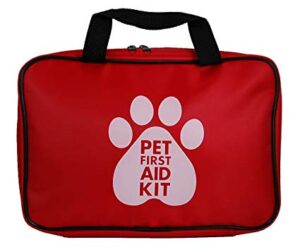
Hiking with Dogs Tip 10: First Aid kit basics
Well stocked pet stores often carry pre-made pet first aid kits for less than $30 which are convenient (we tend to leave on in the car for Shadow) but if you want to assemble your own, pack these items:
- Any special medicines / medications your dog may need
- Duct tape and old clean wool socks that can be taped on as a bootie bandage to protect an injured paw
- Gauze and heavy duty bandages
- Pet-friendly antiseptic, antibiotic ointment
This obviously is just a starter checklist for new hikers and their dogs, but if I’ve missed any of your favourite doggy hiking tips or must haves, please tell us below!



